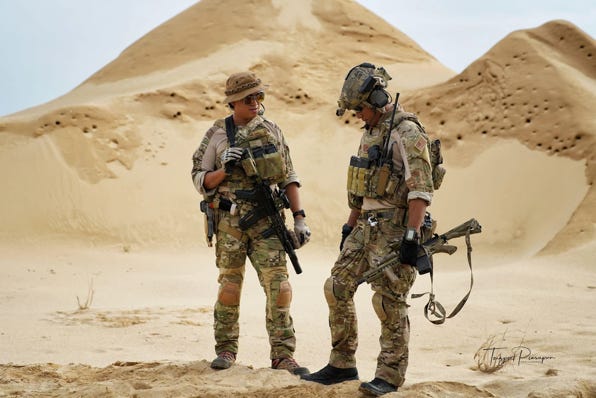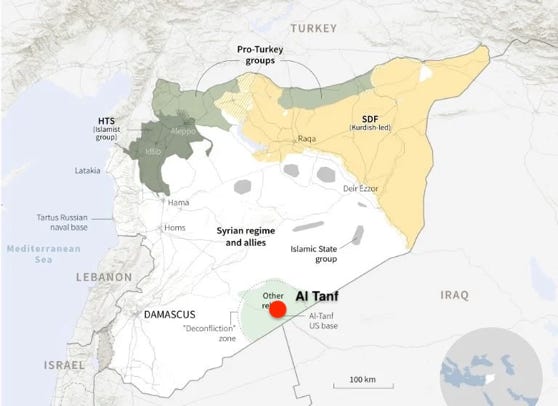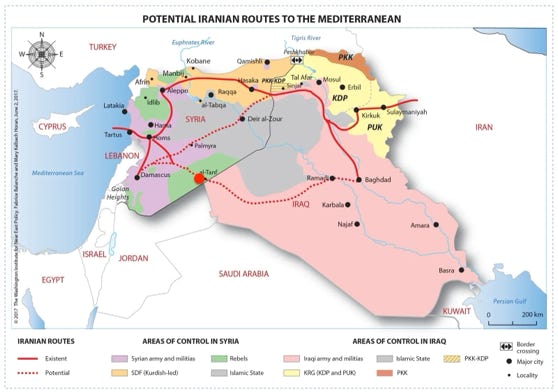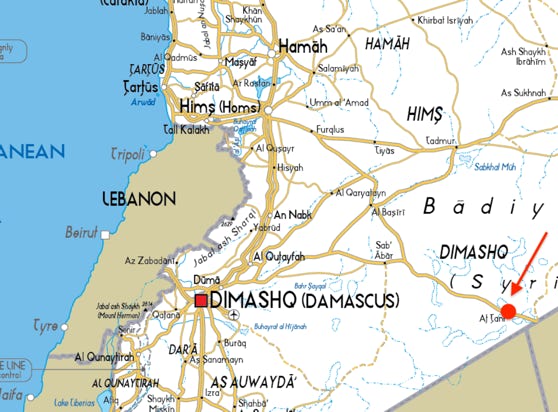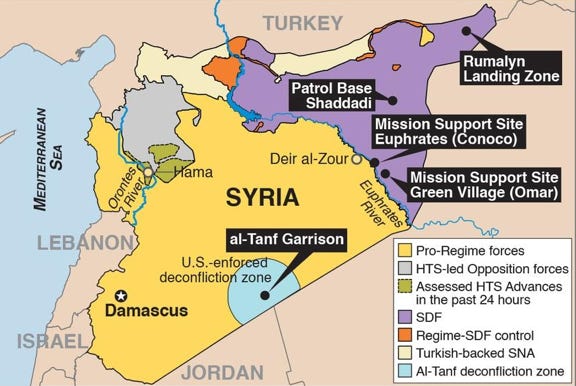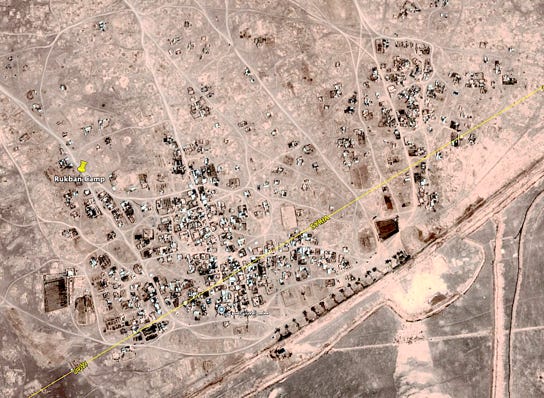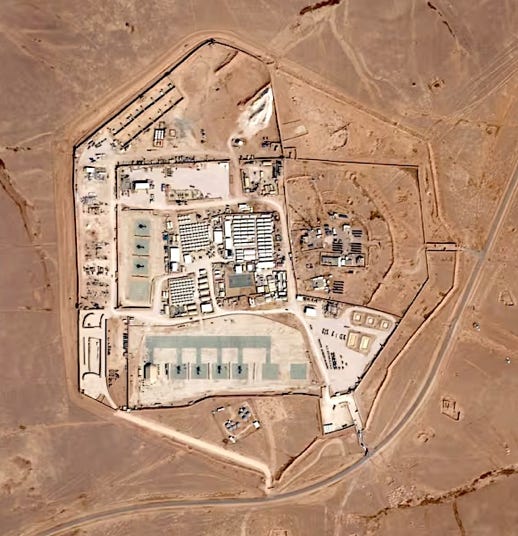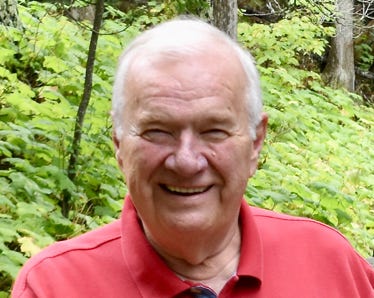DUTY, HONOR, COURAGE, RESILIANCE
Talking Proud: Service & Sacrifice
Syria: A fractured state
Venture into the unfamiliar
US troops in Syria: Al-Tanf Base & Tower 22, in Jordan
Tess Bridgeman echoed my feelings about Syria: "The battlespace in Syria has long been messy, at best.” Amen. As an aside, Ms. Bridgeman addresses legal issues related to the US involvement in Syria, which is well worth a read.
The al Tanf base in southern Syria, in the al-Hamad (Syrian desert), only 10-15 miles from the borders of Jordan and Iraq, comes in two parts for my purposes:
- Al Tanf Garrison: Shown in the opening photo
- Deconfliction Zone: A 34-mile (55 km) radius zone extends from the al Tanf base.
Al Tanf Garrison
The US Special Forces used al Tanf during the Second Gulf War and the 2003 invasion of Iraq. CJTF-OIR reopened the base in 2016. Syrian Highway 2 - Iraqi Highway 1 connect Damascus to Baghdad. The primary missions are twofold:
- Prevent the resurgence and reconstitution of IS.
- Thwart Iran’s strategic goal to establish an east-west land corridor stretching from Iran to Lebanon and block Iranian proxy forces and arms supply channels to Hezbollah and the Mediterranean Sea.
At any one time, 100 to 200 US ground forces are deployed to al Tanf, and on occasion, more. When doing a troop headcount, I assume there are about 200.
The base is about 160 miles due east of southern Lebanon and about 165 miles east-northeast of the Golan Heights. The Golan once was part of Syria, but Israel annexed it in 1981, and the US recognized it in 2019. Israel has constructed settlements in the Golan.
Deconfliction Zone
The Deconfliction Zone (DCZ) emerged in 2016 as the result of “an understanding between the US and Russian Federation to deconflict efforts to defeat ISIS.”
IS had controlled much of the territory around the garrison. Once its troops were expelled, the CJTF set up a 55-kms (34 mile) radius zone from al Tanf garrison.
The zone enables the US and other friendly forces to leave the fixed garrison base and engage potential hostile forces “out there” instead of “in here.” The International Crisis Group describes al-Tanf “as a launching point for counter-ISIS operations and training for Syrian opposition factions fighting the jihadist group.”
The US has calculated that the zone keeps an array of pro-Assad or Iran-backed forces away from the base. They can expect the US to engage them if such forces cross into the zone.
In addition, the US has allowed two activities to occur in the de-confliction zone:
- The zone contains an amalgam of militias. One group consists of former Syrian military officers, Jaysh Maghawir al-Thawra (MaT), also known as the Revolutionary Commando Brigade.
- Syrians displaced by the Syrian civil war, IS offensives of 2014, and other upheavals have located at the Rukban camp on the border with Jordan and within the zone.
Mohannad al-Talaa, a MaT leader, told Almonitor that military members from five other countries, two of which were Arab, were with the Americans. This is intriguing. The airways are filled with the “US Coalition,” but discovering what militaries are in the coalition on the ground is very hard. I am pretty sure there are multiple Arab militias scattered about in the DCZ, but it is consuming to assemble that puzzle.
For example, a Global Security report reflected that the Martyrs of Al-Qaryatayn Brigade, the Army of Tribes faction, Martyr Ahmed al-Abdo Forces, and the Lions of the East contribute to coalition operations in the DCZ. Another one from another article is the Al-Qaryatayn Brigade. As I said, this subject is tiring so I’ll leave it. I am more interested in the nationalities participating in al Tanf.
I have seen vague reports that the Brits, Czechs, French, and Norwegians have been involved at al Tanf, but nothing concrete. Czechoslovakia has been representing the US diplomatically in Damascus.
In 2018, CENTCOM said, “MaT members conduct daily counter-Daesh patrols to provide security and stability within the DCZ.” They have also interdicted drug smuggling operations. The Department of Defense Inspector General estimated that MaT was about 300 strong.
However, in October 2022, Jaysh Maghawir al-Thawra changed its name to the “Free Syrian Army.” This was done as the US replaced al-Talaa with a new commander, Farid al-Qassem, due to corruption charges.
The DCZ has had the secondary effect of attracting Syrians displaced by the Syrian civil war and IS offensives of 2014. They have settled at the Rukban camp, about 30 miles south of al Tanf. I believe this Google image shows the camp. The Rukban camp straddles the Syria-Jordan border, though most of its population is in Syria.
Amnesty International estimated that 80,000 people lived in the Rukban camp at one time, and the current estimate is that 8,000 people live there. Amnesty International believes these people are a US responsibility since they live in this zone.
I’m not sure the US has accepted that responsibility. In 2019, CENTCOM said,
“The United States fully supports a process to allow displaced persons movement that is free from coercion and … welcomed the involvement of appropriate UN agencies in this endeavor.”
In another 2019 statement, CENTCOM said it and its partners would provide security for UN humanitarian convoys within the DCZ.
In its July-September 2024 report to Congress, the lead Inspector General said,
“CJTF-OIR reported that all open routes into Rukban are now controlled by pro-regime forces; there are no alternate supply routes available.”
Incredibly, Russian ground forces came down to southern Syria, reinforced Assad regime forces, and blockaded the camp. The US Holocaust Museum reported in March 2024,
“The Assad regime and its allies have laid siege to the camp, preventing food, medicine, and other essential assistance from reaching its residents.”
NPR has said these displaced Syrians are “hemmed in by Syrian regime and Russian forces.”
Tower 22, Jordan
I need to highlight the logistics facility at Tower 22 in Jordan, about 20 miles south of al Tanf. Iason Athanasiadis reported for the Stimson Center that “the base includes engineering, aviation, logistics, and security elements.” Tower 22 supports al-Tanf and the other US bases in Syria.
An Airman stationed at Tower 22 said Logistics was “a small part of the mission, amounting to weekly food and fuel deliveries to the nearby Al-Tanf base.” The Airman is quoted as saying,
“The main purpose of Tower 22 is to operate drones to spy on insurgents in Iraq and Syria for targeting purposes. The main objective I witnessed was taking out targets.”
This makes sense to me.
On January 28, 2024, a drone attacked the Tower 22 compound that killed three US military members, all belonging to the 718th Engineer Company of the US Army Reserve in Georgia. They were Sgt. William Rivers, 46; Specialist Kennedy Sanders, 24; and Specialist Breonna Moffett, 23; all Georgia natives. More than 40 others were injured, of whom eight were air-evacuated to Landstuhl Hospital in Germany. Most of the injured belonged to the National Guard from several states.
Local air defenses failed to intercept the drone. BBC reported,
“A defence official told the BBC's US partner CBS News that the enemy drone came in ‘very low and very slow’ at the same time that an American drone was returning to the base from a mission. The auto-response features of the base's air defence system were turned off so as not to shoot down the US drone, the official said.”
BBC said there were about 350 US military members stationed at Tower 22. An Iranian drone, the Shahed-101, was used in this attack. It is believed that an Iranian-backed militia, perhaps Hezbollah, conducted the attack.
Corporal Allan Valenzuela was injured in the blast. He was evacuated to Landstuhl and then on to Walter Reed in Washington, suffering from traumatic brain injury. He was intubated before going to Landstuhl, having “sustained multiple fractures of his extremities, soft tissue injuries, traumatic retinopathy, and shrapnel wounds.”
Three USAF members, Sgt. Michael Byrne, 129th Maintenance Squadron, Senior Airman Herland Antezana, and Staff Sgt. Dustin Dinkelacker, assigned to the 129th Rescue Wing, was knocked out and lost consciousness from the attack.
Most of the injured returned to duty.
Click to zoom graphic-photo
